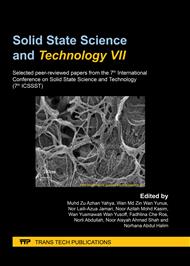[1]
O. Grigoryeva, A. Fainleib, O. Starostenko, I. Danilenko, N. Kozak, G. Dudarenko, Ground tire rubber (GTR) reclamation: Virgin rubber/reclaimed GTR (RE) vulcanizates, Rubber Chem Technol. 77 (2004) 131-146.
DOI: 10.5254/1.3547806
Google Scholar
[2]
A.A. Yehia, M.A. Mull, M.N. Ismail, Y.A. Hefny, E.M. Abdel‐Bary, Effect of chemically modified waste rubber powder as a filler in natural rubber vulcanizates, J. Appl. Polym. Sci. 93 (2004) 30-36.
DOI: 10.1002/app.20349
Google Scholar
[3]
T.D. Sreeja, S.K.N. Kutty, Cure characteristics and mechanical properties of natural rubber/reclaimed rubber blends, Polym. Plast. Technol. Eng. 39 (2000) 501-512.
DOI: 10.1081/ppt-100100043
Google Scholar
[4]
J.K. Kim, R.P. Burford, Study on powder utilization of waste tires as a filler in rubber compounding, Rubber Chem. Technol. 71 (1998) 1028-1041.
DOI: 10.5254/1.3538508
Google Scholar
[5]
N. Rattanasom, A. Poonsuk, T. Makmoon, Effect of curing system on the mechanical properties and heat aging resistance of natural rubber/tire tread reclaimed rubber blends, Polym. Test. 24 (2005) 728-732.
DOI: 10.1016/j.polymertesting.2005.04.008
Google Scholar
[6]
D. De, D. De, Processing and material characteristics of a reclaimed ground rubber tire reinforced styrene butadiene rubber, Materials Sciences and Applications 2 (2011) 486-496.
DOI: 10.4236/msa.2011.25066
Google Scholar
[7]
S. Ramarad, M. Khalid, C.T. Ratnam, A.L. Chuah, W. Rashmi, Waste tire rubber in polymer blends: A review on the evolution, properties and future, Prog. Mater. Sci. 72 (2015) 100-140.
DOI: 10.1016/j.pmatsci.2015.02.004
Google Scholar
[8]
S.-C. Han, M.-H. Han, Fracture behavior of NR and SBR vulcanizates filled with ground rubber having uniform particle size, J. Appl. Polym. Sci. 85 (2002) 2491-2500.
DOI: 10.1002/app.10575
Google Scholar
[9]
G.J. Lake, P.B. Lindley, Cut growth and fatigue of rubbers. II. Experiments on a noncrystallizing rubber, J. Appl. Polym. Sci. 8 (1964) 707-721.
DOI: 10.1002/app.1964.070080212
Google Scholar
[10]
J.R. Halladay, F.J. Krakowski, The use of fatigue crack propagation testing in rubber compound development, Rubber World 239 (2009) 28-31.
Google Scholar
[11]
M.D. Ellul, Mechanical fatigue, in: A.N. Gent (Ed.), Engineering with Rubber, How to Design Rubber Components, Hanser, New York, 1992, pp.139-176.
Google Scholar
[12]
P. Ghosh, R. Stocek, M. Gehde, R. Mukhopadhyay, R. Krishnakumar, Investigation of fatigue crack growth characteristics of NR/BR blend based tyre tread compounds, International Journal of Fracture 188 (2014) 9-21.
DOI: 10.1007/s10704-014-9941-9
Google Scholar
[13]
M.H. Halim, Truck tyre tread rubber: compounding and abrasion resistance, Loughborough University (1990).
Google Scholar
[14]
H.J. Kim, G.R. Hamed, On the reason that passenger tire sidewalls are based on blends of natural rubber and cis-polybutadiene, Rubber Chem. Technol. 73 (2000) 743-752.
DOI: 10.5254/1.3547618
Google Scholar
[15]
P. Ghosh, R. Mukhopadhyay, R. Kankroli, R. Stoček, Durability prediction of NR/BR and NR/SBR blend tread compounds using Tear Fatigue Analyser, Kautsch Gummi Kunstst (2016).
Google Scholar
[16]
K. Reincke, W. Grellmann, G. Heinrich, Investigation of mechanical and fracture mechanical properties of elastomers filled with precipitated silica and nanofillers based upon layered silicates, Rubber Chem Technol. 77 (2004) 662-677.
DOI: 10.5254/1.3547843
Google Scholar
[17]
D.H. Abang Ismawi Hassim, F. Abraham, J. Summerscales, P. Brown, The effect of interface morphology in waste tyre rubber powder filled elastomeric matrices on the tear and abrasion resistance, Express Polymer Letters 13 (2019) 248-260.
DOI: 10.3144/expresspolymlett.2019.21
Google Scholar
[18]
Information on https://imagej.nih.gov/ij/.
Google Scholar
[19]
Information on http://imagejdocu.tudor.lu/doku.php?id=plugin:segmentation:active_contour:start.
Google Scholar
[20]
D.H. Abang Ismawi Hassim, F. Abraham, J. Summerscales, Fatigue crack growth and fatigue fracture morphology of recycled rubber powder filled NR/BR blend compound: Rubber Chemistry and Technology In-Press (2020).
DOI: 10.5254/rct.20.80440
Google Scholar
[21]
F. Abraham, The influence of minimum stress on the fatigue life of non strain crystallising elastomers, Coventry University (2002).
Google Scholar
[22]
B. Dong, C. Liu, Y.-P. Wu, Fracture and fatigue of silica/carbon black/natural rubber composites, Polym Test. 38 (2014) 40-45.
DOI: 10.1016/j.polymertesting.2014.06.004
Google Scholar
[23]
B.N.J. Persson, O. Albohr, G. Heinrich, H. Ueba, Crack propagation in rubber-like materials, J Phys: Condens Matter 17 (2005) R1071.
DOI: 10.1088/0953-8984/17/44/r01
Google Scholar
[24]
A.R. Payne, Hysteresis in rubber vulcanizates, Journal of Polymer Science:Polymer Symposia 48 (1974) 169-196.
DOI: 10.1002/polc.5070480114
Google Scholar
[25]
W.V. Mars, A. Fatemi, Factors that affect the fatigue life of rubber: A literature survey, Rubber Chem. Technol. 77 (2004) 391-412.
DOI: 10.5254/1.3547831
Google Scholar
[26]
G. Weng, H. Yao, A. Chang, K. Fu, Y. Liu, Z. Chen, Crack growth mechanism of natural rubber under fatigue loading studied by a real-time crack tip morphology monitoring method, RSC Advances 4 (2014) 43942-43950.
DOI: 10.1039/c4ra06518b
Google Scholar
[27]
C. Neogi, A.K. Bhowmick, S.P. Basu, Hysteresis Loss of Swollen Rubber Vulcanizates in Force-Retraction Measurement and Dynamic Mechanical Analysis, Journal of Elastomers & Plastics 23 (1991) 152-163.
DOI: 10.1177/009524439102300206
Google Scholar
[28]
P.B. Lindley, Relation between hysteresis and the dynamic crack growth resistance of natural rubber, International Journal of Fracture 9 (1973) 449-462.
DOI: 10.1007/bf00036325
Google Scholar
[29]
M. Flamm, J. Spreckels, T. Steinweger, U. Weltin, Effects of very high loads on fatigue life of NR elastomer materials, Int. J. Fatigue 33 (2011) 1189-1198.
DOI: 10.1016/j.ijfatigue.2011.03.008
Google Scholar
[30]
G.R. Hamed, Molecular aspects of the fatigue and fracture of rubber, Rubber Chem. Technol. 67 (1994) 529-536.
DOI: 10.5254/1.3538689
Google Scholar
[31]
G.J. Lake, Fatigue and fracture of elastomers, Rubber Chem. Technol. 68 (1995) 435-460.
Google Scholar
[32]
B. Dong, C. Liu, Y. Lu, Y. Wu, Synergistic effects of carbon nanotubes and carbon black on the fracture and fatigue resistance of natural rubber composites, J. Appl. Polym. Sci. 132 (2015) 42075.
DOI: 10.1002/app.42075
Google Scholar


